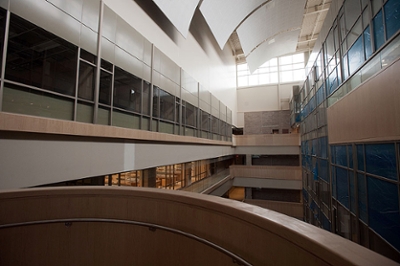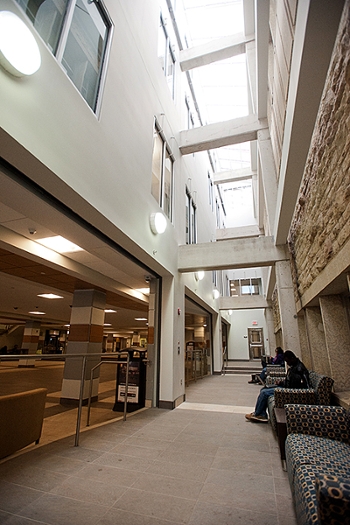Newest LEED Addition to U of S in Strong Company
The certification of Health Sciences E-Wing as LEED Gold is the latest in many energy efficient and environmentally friendly building projects on campus.
By Matt Wolsfeld
After nearly a decade of planning, construction, and implementation, the renovations and additions to the Health Science building complex are nearly complete. The building’s newest wings in particular – D-Wing and E-Wing – saw a great amount of consideration put into their sustainability features and emissions footprint. Now, just in time for Energy Conservation Month, Health Science’s E-Wing has finally been given a LEED Gold certification from the Canadian Green Building Council.
A huge amount of work and effort goes into creating a green building, which makes this accomplishment all the more sweet to everyone who has been involved in it. LEED certification is an independent, third-party verification that a building was designed and built with high standards for human and environmental health. Each rating consists of a series of prerequisites (required elements) and credits (optional elements to pursue higher ratings), all adding up to four possible levels of certification (certified, silver, gold and platinum).
The University of Saskatchewan has made great strides in its green building efforts, having now achieved LEED ratings on 5 of its buildings: the Place Riel Student Centre Expansion, the Murray Building University Learning Commons and Health Science D-Wing have all been given LEED Silver certification, while the College of Law Addition and now Health Science E-Wing have received LEED Gold certification. Now, as we find ourselves ending a decade of new capital development at the university, we can take pride in a variety of energy-saving, environmentally-friendly, and human-oriented spaces on campus.
It hasn’t been easy achieving these certifications, but the work we have put in has resulted in numerous interesting and effective features in these buildings. The first step in obtaining LEED certification is often to look at the basic building structure and start with an efficient and environmentally-friendly skeleton. One way to do this is to produce highly effective building envelopes that keep warm air in and cold air out. Lighting use is incredibly subject to human error and inefficiencies, so much of the lighting in these new buildings is automated to ensure that lights remain off after hours or when lots of daylight is available. Sensors are also used to tell when a room is occupied to allow smart ventilation technologies to heat or cool the building as needed.

Once the skeleton is in place is when green buildings really get to shine by showing off their more visible components. Both the College of Law Addition and Health Science D-Wing are home to living roofs, aka roofs that are designed to support healthy and vibrant plant populations. These roofs don’t just give occupants something pretty to look at: the extra greenery allows for limited carbon capture while acting as a solid insulator to keep the room under it well enclosed. The Murray Building University Learning Commons was designed almost entirely with demountable wall partitions in office areas, which helps reduce construction waste and allows for much more flexible office layouts to provide a free and open work environment. Incorporating the surrounding environment into a building is an important part of its green status; a portion of Health Science E-Wing’s Gold certification is due to the adjacent native prairie pond habitat that was built to collect and manage stormwater runoff while simultaneously supporting plant and wildlife populations.
In the end, the numbers speak for themselves with green buildings. By taking the time to design and build a green building, extra work and costs translates into much higher savings and efficiencies in the long-run. Being diligent during the construction phase has allowed us to reduce landfill construction waste by enormous amounts (85% for the College of Law Addition and 75% for the University Learning Commons and Place Riel Expansion). More efficient building envelopes have helped us increase building space on campus while seeing virtually no increase in energy or heating use. In Health Science E-Wing, up to 80% of the energy used to heat water is being supplied by solar collectors rather than the power grid, reducing emissions and saving us money at the same time. Savings like these compound year after year, making green buildings financially responsible in addition to being environmentally responsible.
Given the success we have seen in the past decade with green buildings, the university is pursuing options for a Green Building Policy on campus that would set certain standards for all new buildings to have green features and receive LEED certification. As an important and leading institution in the province, it is our responsibility to set a positive and responsible example in the area of green buildings. Here’s hoping to see this work continued on far into the future!
